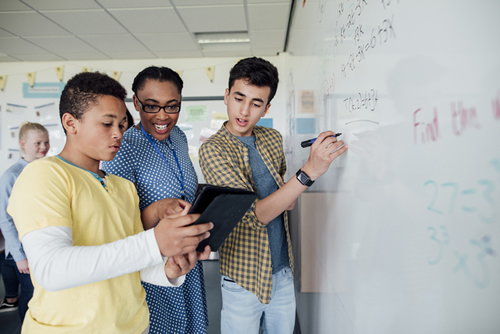We may technically be in the middle of a school year, but starting a new calendar year has us looking at and forecasting the new K12 education trends we expect to see in 2019.
In the first half of this school year, we’ve seen some of these ideas start to emerge, and we suspect that as we close out the academic calendar, they will become more prominent. In fact, we’re excited to see what role these trends will play going forward and into the 2019-2020 school year.
K12 trends in education
1. Increased use of immersive technologies
Virtual and augmented reality (VR and AR) have been creating new opportunities in teaching and learning. As the technologies become more affordable and available, we expect to see their usage increase dramatically in K-12 education. It gives teachers the ability to show their students aspects of history, travel, and STEM subjects in an immersive experience. Students will be able to take “field trips” across the world and gain hands-on vocational training through VR simulations without ever leaving the classroom. See how a district in Pennsylvania is investing in VR and AR.
2. Rising prominence of assistive devices
Assistive devices (e.g., Google Home, Amazon’s Alexa, and Apple’s Siri) have carved out their space in many people’s homes, but 2019 will see them gain prominence in classrooms. While there are still some privacy issues to address, assistive devices can update information published in outdated textbooks and give students a space to dive deeper into their own learning by asking questions and following up on their own curiosities.
3. Growth of integrated learning
We’ve been seeing more schools across the board adopting integrated learning solutions that combine print materials and textbooks with digital aids. It’s impractical for schools to wait for a complete computerized transformation; integrated learning helps bridge the gap and bring them into a digital world. We predict that more textbook publishers will release digital assets that are easy to use and connect to their products.
4. Expansion of blended learning
Blended learning takes integrated learning up a notch, by moving a portion of instruction fully online. Some districts have already been relying on blended learning for students to make up missed classes due to temporary school closures. This method of education also prepares K-12 students for higher education, where online learning is more common.
5. Introduction of “digital backpacks”
The Common Education Data Standards (CEDS) efforts have been in place for almost a decade now, but technology has made it easier for schools to securely share information. More schools will begin implementing—or look to improve—their systems for “digital backpacks.” These will follow students throughout their K-12 academic career, and will give teachers access to test results, student’s strengths and weaknesses, individual needs, and notes from previous educators. This should help teachers develop effective personalized learning plans to help their students transition into new classrooms.
6. Higher degrees of personalized learning
While we won’t be moving away from standardized testing any time soon, we do see more schools leaning toward personalized learning methods. Online charter schools seem to be leading the charge with this trend. Innovative technologies have given teachers a way to monitor student progress in more individualized ways, which allows them to tailor their instruction to benefit their students and help them be more successful.
7. Stronger understanding of student progress
The Internet of things (IoT), or the interconnection of our digital devices and everyday objects, will help teachers better monitor student progress. At its full capacity, IoT can help teachers and parents track their student’s homework—when it was completed, how long it took to complete—to help them understand which teaching methods or assignments are the most advantageous. It can also help students, teachers, and parents engage in real time, about assignments and learning material.
8. Greater digital security
Of course, the more common technology becomes in the classroom, the more schools will need to focus on cybersecurity. Educators will make it a priority to protect their students across digital environments, but we suspect AI developments will make avoiding potential threats much easier. Parents will install security apps on their child’s devices, and they will be commonplace in the classroom.
9. Getting students ready for the real world
Higher education seems to be directing its attention on developing workforce and entrepreneurial skills. We think this will trickle down to K-12 instruction. Schools will focus on providing students with the resources to learn skills that will help them in the current economy. Here’s how one district is supporting college and career readiness.
10. Edtech companies will have more influence on curriculum
With schools aiming their attention on skill-based education, we’ll see edtech companies jumping in and looking for opportunities to shape curriculum. The country’s current administration appears to favor privatization in education sectors, and we think that will create space for edtech companies to influence what is taught in classrooms.
- 4 strategies that bring nature’s power to your classroom - May 8, 2024
- 3 ways a modern data solution can improve student outcomes - May 7, 2024
- 7 principles of outdoor learning for early childhood - May 7, 2024

